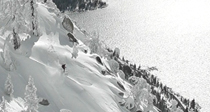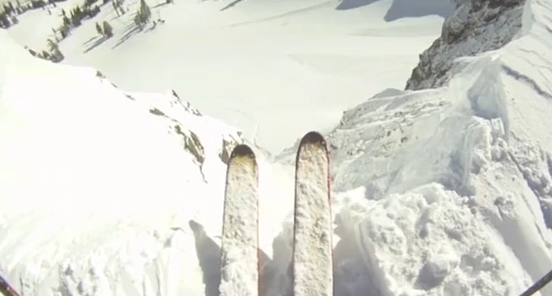by Susan Schnier
 WhenMt.Rose opened the chutes last season, the mountain rocketed from family status to become one of the most hard core ski areas in Tahoe. Highly avalanche prone, the tantalizingly steep couloirs were closed and frequently poached since the 1960’s. Now intrepid skiers have free reign of the 200 acre area. Offering 1500 vertical feet of the driest snow in Tahoe, the chutes hold powder for days and stay chaulky throughout the season. Patches reaching up to 55 degrees are enough to speed the pulse of the most seasoned big mountain skier, 35-degree sections give the advanced skier a chance to build up to the big stuff, and plenty of sustained 40-45-degree sections offer all-day leg-burners.
WhenMt.Rose opened the chutes last season, the mountain rocketed from family status to become one of the most hard core ski areas in Tahoe. Highly avalanche prone, the tantalizingly steep couloirs were closed and frequently poached since the 1960’s. Now intrepid skiers have free reign of the 200 acre area. Offering 1500 vertical feet of the driest snow in Tahoe, the chutes hold powder for days and stay chaulky throughout the season. Patches reaching up to 55 degrees are enough to speed the pulse of the most seasoned big mountain skier, 35-degree sections give the advanced skier a chance to build up to the big stuff, and plenty of sustained 40-45-degree sections offer all-day leg-burners.
Line 1 – Cardiac Ridge
For adrenalin pumping, cornice hucking, hit the chutes on the ridge line under the Northwest chair, entering through the Jackpot gate. Cardiac Ridge has the highest heartbeat factor, requiring a crux first move. To avoid having to make an important first move and the potential lift humiliation if you blow it, go lower and ski Cutthroat where it’s still steep, but wider – be prepared to get your zipper line on, as it often gets bumped up quickly. Good carnage in this area is usually visible from the lift.
Line 2 – Captivator
The El Cap gate accesses the steepest, longest section of the chutes. To avoid the mainstream rush and find some privacy, go straight through the gate and you’ll be at the top of the El Cap. Angle right into the 45+ degree Captivator – this is the only entrance. Unlike the saddle and El Cap, Captivator is not a dished-out natural half-pipe; it’s more level and it gets tight through the trees (about four ski-lengths wide) before opening up at the bottom.
Line 3 – Saddle
Enter through the El Cap gate and wrap around the flat area to the top of the Saddle. It starts out as an open bowl and then funnels you into the 40-degree chute, narrowing to about two ski lengths at the throat. Like all of the chutes, you can see the pinch and choose to go around if you’re not up for sweating out hop turns – there’s nowhere you’ll be closed in, you always have options. Getting east from the Saddle is hard, so choose a lower gate if you’re headed that way.
Line 4 – Dragon Lady
The most confining and the challenging chute, this line is sandwiched between two small spines. Accessed from the Yellow Jacket gate, it’s to the skiers left of Fuse and skier’s right of the Saddle. From the gate, hike to the west (left), start at the top of Fuse and angle left toward the Saddle. There’s a sign on a tree about 50 yards from the ridge. In the pinch, smack in the middle of the chute, is a tree with a barely a ski length on either side.
Line 5 – Beehive
Take some groomed warm up turns down the Mine Train traverse to get to the Beehive gate and head in any direction from there. The terrain is 30-35 degrees and it’s relatively wide open in either direction. This chute is shorter than the others, since you loose vertical by dropping down the ridge and ending in the flats. The upside: you can’t be seen by the lift so you can be out of sight while building up your “chute legs.”
Line 6 – Venom
Go through Hornet’s Nest gate and stay to the left and on top of the ridge while you ski down the top section of Hornet’s Nest – don’t slide down into the throat or you’ll miss it. Halfway down there’s a small cliff band – one of the few in the chutes. Two or three mini-couloirs split the rocks below the cliff. Come out though the tight trees at the bottom.
Line 7 – 09’er
Go in the Nightmare Gate (the lowest on the east side), ski about 100 yards down the ridge, and angle left to Chaos, a cut chute sandwiched by glades. Chaos was cut in 2004 and the mountain did more cutting this past summer to open it up even more. 09’er, to the left of Chaos, offers Coloado-esque tree skiing. Though you’ll lose vertical on the traverse down the ridge, this run is almost as long and steep as the bigger chutes because it has a consistent pitch all the way down to the lift instead of funneling into the flats.
Line 8 – Goat Track
The Northwest Magnum 6 and the Blazing Zephyr 6 lifts get you to the top of the chutes. If you ski all the way to the bottom, you have to take the Chuter lift and make a two-lift circuit. The bottom bowl area of the chutes has a groomed loop that’s makes a fairly long, low-angle run. It’s spackled with natural terrain park features like wind lips, whopdee-doos and dishes. Speedy skiers can make a full two-lift lap in less than 15 minutes. Often, a traverse track develops below the western chutes and you can do single-lift laps on Northwest, accessing everything from El Cap west. Make sure the track is in place, or be willing to put in the effort to help set it.




Recent Comments